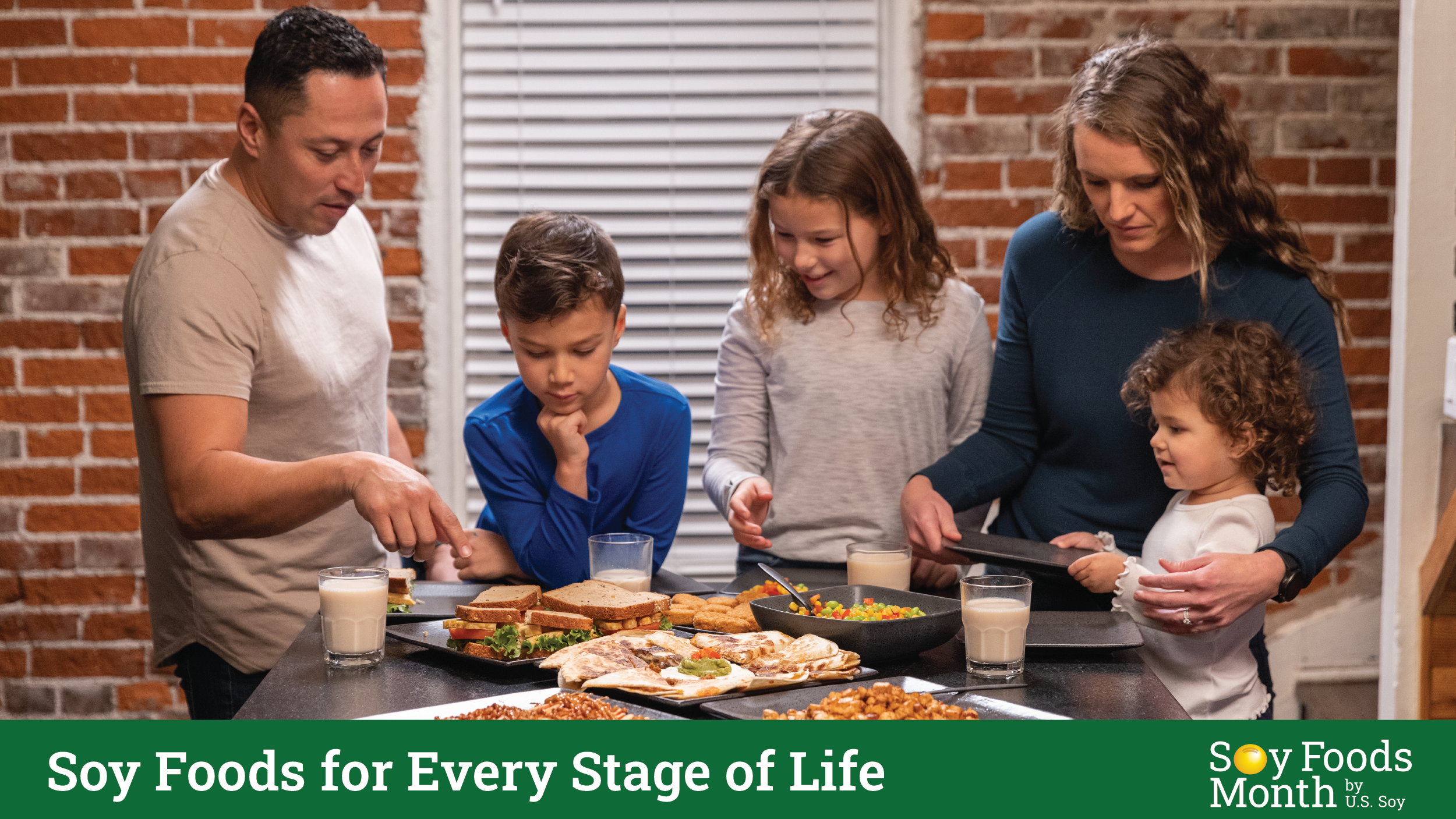
A wide array of soy food grocery products step into the spotlight in the U.S. during National Soy Foods Month in April. The month-long celebration encourages consumers to cook with soy ingredients and incorporate soy foods into their diet. High-quality soy protein from U.S.-grown soy also holds year-round appeal for global consumers. Factors such as rising grocery prices and altered shopping styles may influence more plant protein consumers to choose soy foods. The following considerations demonstrate why affordable soy is well-positioned.
Shopping Styles with Staying Power
Today’s innovative retail models may offer opportunities for the soy foods industry. As the global pandemic gathered momentum, shoppers have adopted new ways of accessing what they want, without having to rely solely on in-store shopping.[1] Today’s omnichannel food shopping options include in-store grocery shopping, home delivery, and online shopping. According to a recent survey of American shoppers, 72 percent have purchased groceries online in the past three months, the same percentage as last year. More than half of the survey participants (56 percent) reported ordering online more frequently than they did a year ago, with snack foods being the most popular online grocery items.[2]
Online shoppers are driven by convenience, with approximately 74 percent saying it’s their top motivator. Price is the second-most important driver of their buying decisions.[3] Shelf-stable soy food options include soy milk, soy nuts, silken tofu, and TSP (textured soy protein, also known as TVP or textured vegetable protein). These ingredients meet consumer demands and can be delivered right to their door.
Value-Oriented Retail Gathers Momentum
This spring, a reported 88 percent of U.S. shoppers believe their grocery purchases will be affected by inflation.[4] Global consumers also are projected to gravitate to value-focused shopping channels for essentials including groceries.[5] In the UK, sales for the multinational discount grocery chain Aldi reached £1.4 billion ($1.7 billion) in December for the first time, up 26 percent year on year.[6] Among plant protein options at the chain are its soy-based meatballs and chicken patties, and soy milk.
In the U.S., all generations of shoppers are using social media to help them make grocery shopping decisions and are brand-switching as they look for ways to save. American consumers also look to social media for meal inspiration ideas and recipes.[7] Currently, more than 112,000,000 soy food recipe results can be found in an online Google search, as well as 121,000,000 plant protein recipes.
Generational Shopping Differences
More than half of Gen Z grocery shoppers in the U.S. want social media recipes that link directly to a product they can purchase. Approximately 40 percent of them make weekly decisions based on social media influencer content. YouTube is their number one source of recipe inspiration, followed by TikTok and Instagram. Gen X shoppers (born between 1965 and 1980) are the generation most concerned about affording foods, and switch label brands for price reasons. Approximately 63 percent find grocery product inspiration on Facebook. Millennials (born between 1981 and 1996) are the top online shopping demographic, and 80 percent use social media for grocery product inspiration.[8]
Opportunities for Innovative Soy Foods
In the U.S., health remains a top priority for consumers, with 61 percent of shoppers reporting they plan to eat more healthfully and exercise more. Additionally, 39 percent will prioritize sustainable ingredients.[9] Globally, sustainability is expected to play a role in the value equation for budget-conscious consumers, along with factors such as flexibility and durability. Currently, 76 percent of Indonesian consumers say climate change will affect the foods and drinks they buy, and 59 percent of German consumers believe their behavior can make a positive environmental difference.[10] With the U.S. Soy Sustainability Assurance Protocol (SSAP), sustainable soy foods offer global consumers a variety of ingredient choices to complement their budgets and personal eating philosophy.
Trends in Europe show a rise in healthy indulgences, attributed to increased demand for foods that focus on positive nutrition, or nutrient-dense foods. Examples of healthy indulgences in the snack category include crispy protein snacks and plant-based jerky.[11] Soy food snacks available online range from spicy tempeh chips and tomato flavored soy sticks to soy-based jerky in globally inspired flavors such as teriyaki and smoky chipotle.
Soy foods are not only center-of-the-plate choices. In today’s competitive market, they also offer beverage, snack, and dessert options to meet global consumer demand.
#
This article was (partially) funded by the United Soybean Board.
[1] Euromonitor International, The Coronavirus Era: The Future of Where and How Consumers Shop. March 2021. https://go.euromonitor.com/rs/805-KOK-719/images/The_Coronavirus_Era_The_Future_of_Where_and_How_Consumers_Shop.pdf
[2] Chicory. 2023 Online Grocery Shopping Report. “Chicory Survey Indicates Greater Reliance on Online Grocery Shopping.” https://chicory.co/blog-feed/online-grocery-shopping-report-2023-press-release
[3] Chicory. 2023 Online Grocery Shopping Report.
[4] Inmar Intelligence. New Spring Shopping Report Shows Brands that Don’t Offer Savings Risk Losing Loyal Customers. Press Release. March 1, 2023.https://www.inmar.com/blog/press/new-spring-shopping-report-shows-brands-dont-offer-savings-risk-losing-loyal-customers
[5] Euromonitor International, The Coronavirus Era: The Future of Where and How Consumers Shop.
[6] Aldi. “Aldi Scores Record Sales as Customers Celebrate Christmas and the World Cup Together.” Press Release. 2023. https://www.aldipresscentre.co.uk/business-news/aldi-scores-record-sales-as-customers-celebrate-christmas-and-the-world-cup-together/
[7] Progressive Grocer [March 13, 2023]. “From Boomers to Gen Z: How to Reach, Engage and Inspire Different Generations of Shoppers.” [Webinar]. Inmar Intelligence. https://event.webcasts.com/viewer/event.jsp?ei=1600248&tp_key=e4a1ce8269
[8] Progressive Grocer [March 13, 2023]. “From Boomers to Gen Z: How to Reach, Engage and Inspire Different Generations of Shoppers.” [Webinar]. Inmar Intelligence. https://event.webcasts.com/viewer/event.jsp?ei=1600248&tp_key=e4a1ce8269
[9] Inmar Intelligence. 2023 Spring Commerce Report. https://www.inmar.com/trends/2023-spring-trends-guide
[10] Mintel. 2023 Global Trends. https://insights.mintel.com/rs/193-JGD-439/images/Mintel_Global_Consumer_Trends_2023_English.pdf
[11] Food Navigator Europe. “The Rise and Rise of Healthy Indulgence.” Feb 15, 2023. https://www.foodnavigator.com/Article/2023/02/15/the-rise-and-rise-of-healthy-indulgence-in-tough-times-food-offers-opportunity-for-delicious-escapism/
